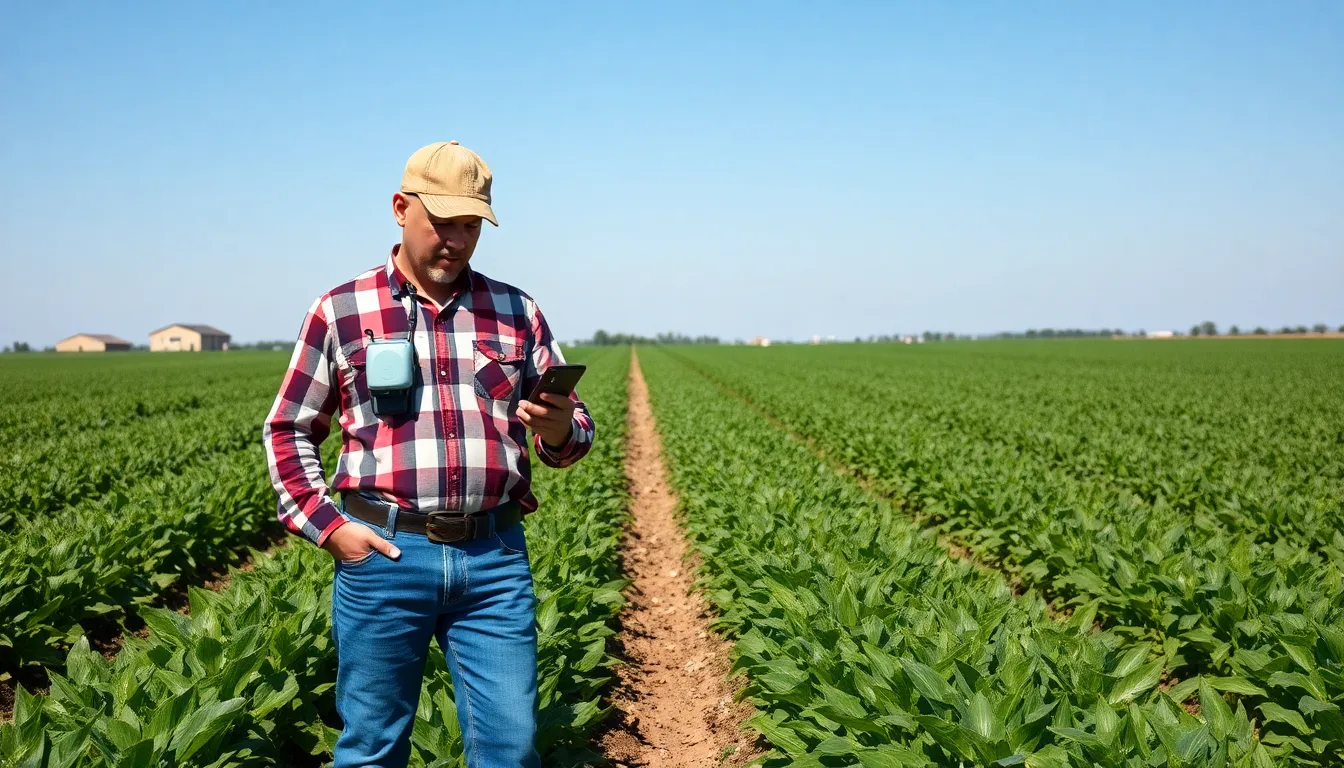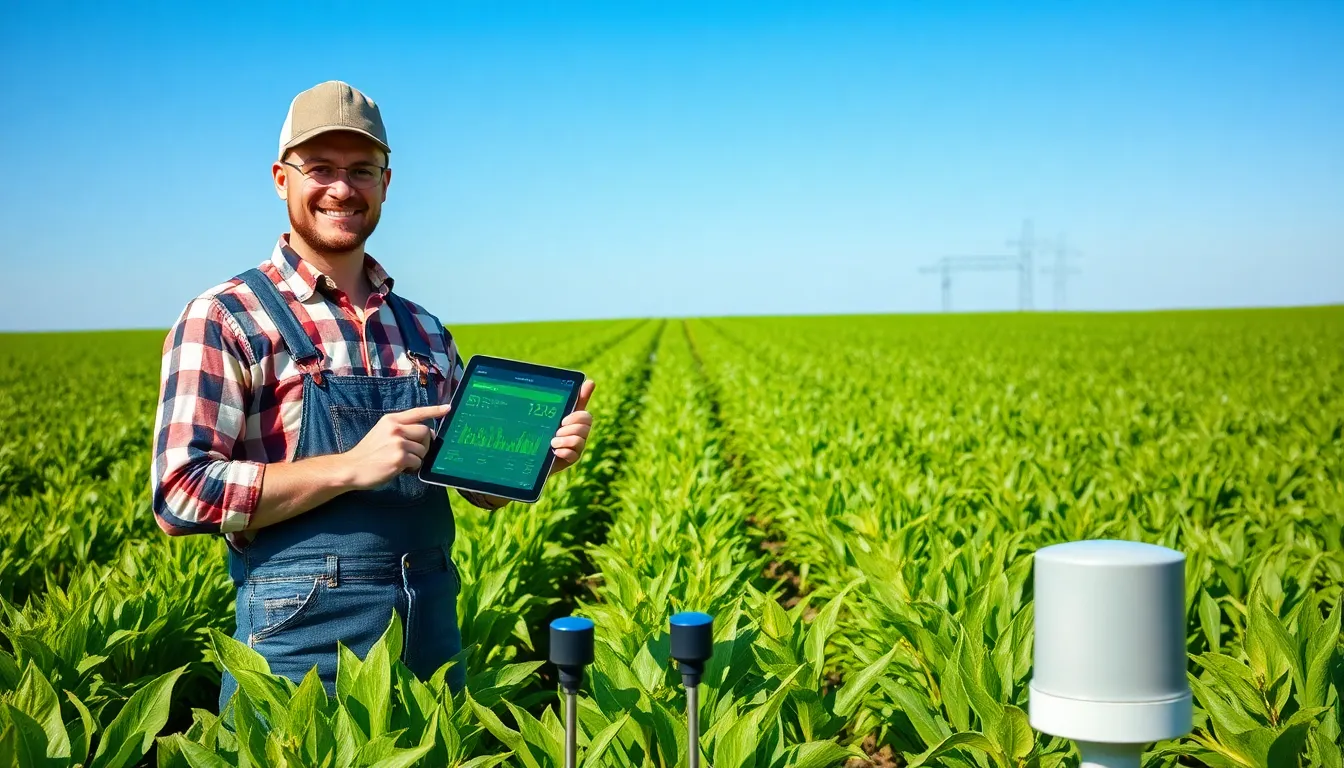In a world where your fridge can text you when you’re out of milk, it’s no surprise that agriculture’s getting a tech makeover too. Welcome to the Internet of Things (IoT) in farming, where sensors and smart devices are transforming the way crops are grown and livestock is managed. Forget the days of guesswork—farmers now have the power of real-time data right at their fingertips.
Table of Contents
ToggleOverview of Internet of Things in Agriculture
The Internet of Things significantly enhances agricultural practices. Smart devices and sensors connected to the internet allow for real-time monitoring across various farming operations. Farmers utilize these tools to collect data on soil moisture, crop health, and livestock conditions.
IoT applications streamline different aspects of farming. Automated irrigation systems optimize water usage based on current soil conditions, leading to efficient water management. Precision agriculture techniques improve crop yields by analyzing data collected from various sensors. These insights enable farmers to apply fertilizers and pesticides more effectively.
Remote monitoring provides numerous advantages. Farmers receive alerts regarding changes in environmental conditions, such as temperature and humidity. Such notifications facilitate timely interventions that can prevent crop losses. Livestock management benefits from IoT tracking systems, allowing farmers to monitor animal health and location in real-time.
Cost savings are an additional benefit of implementing IoT solutions. Farms using these technologies can reduce labor costs and improve resource management. Enhanced decision-making leads to increased productivity, ensuring sustainable farming practices.
Collaboration among technology providers and agricultural stakeholders fosters innovation. Partnerships pave the way for developing new IoT applications tailored to farmers’ specific needs. As technology continues to advance, the Internet of Things will play an even more critical role in transforming agriculture.
Benefits of Internet of Things in Agriculture

The Internet of Things (IoT) brings transformative benefits to agriculture, enhancing various aspects of farming operations.
Improved Efficiency
IoT technologies significantly enhance efficiency by automating routine tasks. Automated systems reduce the need for manual interventions, saving time and effort. Crop monitoring tools provide insights to optimize resource use, leading to better yield management. Sensors that track environmental conditions help farmers make informed decisions on planting and harvesting schedules. Improved irrigation management systems ensure precise water application, conserving vital resources. In turn, these efficiencies lead to reduced operational costs and higher profit margins. Farmers leveraging IoT can achieve sustainable practices that bolster both productivity and environmental stewardship.
Real-Time Data Collection
Real-time data collection plays a crucial role in modern agriculture. Connected devices gather information on soil conditions, weather patterns, and crop health continuously. This instantaneous feedback enables timely decision-making, allowing farmers to address issues before they escalate. Smart sensors that monitor nutrient levels allow targeted fertilization, enhancing crop quality. Data-driven insights lead to tailored interventions, optimizing growth conditions further. Farmers who utilize IoT for data collection can make strategic adjustments to enhance both yield and sustainability. Access to actionable data fosters a proactive approach to farming, positioning growers for success in a competitive market.
Challenges in Implementing IoT in Agriculture
Implementing IoT in agriculture presents several challenges that must be addressed to maximize its potential benefits.
Connectivity Issues
Reliable connectivity remains a primary challenge in the agricultural sector. Many farms operate in rural areas where internet access is limited or absent. Without stable connectivity, the functionality of IoT devices declines, affecting data transmission and real-time monitoring capabilities. Satellite and cellular solutions exist, yet they can be cost-prohibitive for small-scale farmers. In addition, network coverage may vary, leading to inconsistent data access. Investing in improved infrastructure is essential for ensuring that IoT applications operate effectively across diverse agricultural landscapes.
Data Security Concerns
Data security poses significant risks in the realm of IoT for agriculture. Connected devices generate vast amounts of sensitive data, which can be vulnerable to cyber-attacks. Unauthorized access to farm data can lead to severe consequences, including financial losses and breaches of privacy. Farmers need robust security measures to safeguard their systems and data. Utilizing encryption and strong authentication protocols can mitigate these risks. Moreover, ongoing training and awareness about cybersecurity for farm workers play a crucial role in protecting agricultural operations from potential threats.
Case Studies of IoT Applications in Agriculture
Numerous case studies illustrate the impact of IoT applications in agriculture. These real-world examples showcase how technology is transforming various farming practices.
Precision Farming
Precision farming utilizes IoT technology to enhance productivity and resource efficiency. Sensors integrated into the soil provide data on moisture levels, nutrient content, and temperature. Farmers receive this data in real time, enabling informed decisions about irrigation and fertilization. A notable example involves a company using IoT solutions to monitor crop growth, which led to a 20% increase in yield. Drones equipped with cameras and sensors collect aerial data that helps assess crop health. Farmers navigate complex farming challenges with newfound insights, facilitating better resource allocation and sustainable practices.
Livestock Monitoring
Livestock monitoring integrates IoT devices to improve animal health and management. Wearable sensors track vital signs, movement patterns, and feeding habits. These devices alert farmers to health issues before they escalate, allowing for timely interventions. For instance, a farm in California implemented IoT solutions that reduced livestock illnesses by 30%. Mobile applications consolidate data, providing farmers with insights for optimizing breeding and nutrition strategies. Consequently, livestock operations become more efficient, leading to increased productivity and profitability. This innovative approach ensures healthier animals while promoting better welfare standards in livestock management.
Future Trends in Internet of Things in Agriculture
Emerging trends in the Internet of Things (IoT) are set to further revolutionize agriculture. Automation will likely extend beyond simple tasks to more complex processes, enabling farmers to manage their operations comprehensively. Machine learning algorithms will enhance data analysis capabilities, allowing for precise recommendations tailored to specific crops and environments. AI-powered predictive analytics can optimize yield forecasts, helping farmers make better planting and harvest decisions.
Drone technology is expected to gain traction, complementing IoT applications through aerial surveillance of crops and livestock. These drones, equipped with advanced sensors, will capture detailed data on crop health and environmental conditions. The integration of satellite imagery with IoT devices will improve precision farming practices, enabling real-time adjustments in irrigation and fertilization.
Blockchain technology is anticipated to play a pivotal role in data security and transparency within agricultural supply chains. Secure data sharing can enhance traceability of products from farm to market, assuring consumers of quality and sustainability. Farmers will embrace digital platforms that facilitate collaboration with consumers and supply chain partners, maximizing the value of their output.
As smart farming practices expand, the popularity of vertical farming and urban agriculture will likely increase. IoT applications can monitor and manage these systems more effectively, optimizing resource use even in limited space. These innovative farming techniques will drive sustainability, reducing the carbon footprint associated with food production.
Connectivity solutions will also evolve to address existing limitations in rural areas. New satellite and low-power wide-area network technologies aim to improve internet access for farmers, enabling seamless operation of IoT devices. Addressing these connectivity challenges will be crucial for wider acceptance and implementation of IoT technologies in agriculture.
The Internet of Things is undeniably reshaping the agricultural landscape. By harnessing real-time data and automation, farmers can optimize their practices and enhance productivity. The benefits of IoT extend beyond efficiency; they promote sustainability and improve crop quality.
As technology continues to evolve, the potential for IoT in agriculture will expand further. Innovations like machine learning and drone technology will provide even more precise insights. Addressing connectivity and security challenges will be essential for maximizing these advancements.
Embracing IoT not only positions farmers for success but also contributes to a more sustainable and resilient agricultural future. The journey of integrating technology into farming is just beginning, and its impact will be felt for generations to come.





